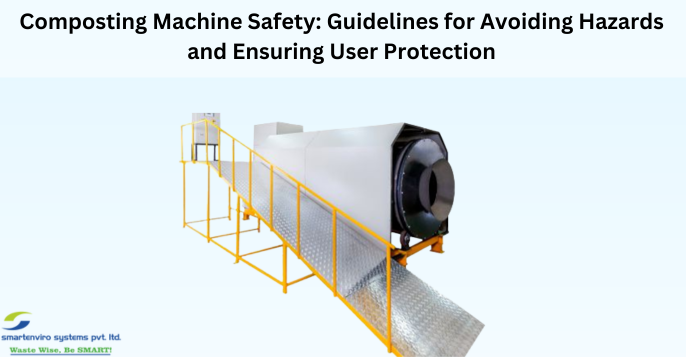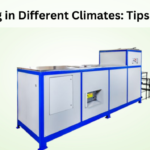Introduction
Composting machines are remarkable tools that make the process of converting organic waste into nutrient-rich compost more convenient and efficient. They help reduce waste and benefit the environment, but it’s essential to use them safely to prevent accidents and ensure user protection. In this comprehensive guide, we will discuss various aspects of composting machine safety, including potential hazards, essential safety guidelines, and best practices for safe operation.
Understanding Composting Machine Hazards
Composter machine, like any equipment, come with their set of potential hazards. Being aware of these hazards is the first step in ensuring safety. Let’s explore some common composting machine hazards:
Moving Parts: Composting machines often have rotating or moving components, such as blades, augers, or drums. Accidental contact with these parts can result in injuries.
Electrical Hazards: Electric-powered composting machine pose electrical risks, including electric shocks or short circuits, which can be dangerous.
Airborne Particles: During the composting process, organic materials can release dust and particulate matter. Inhaling or ingesting these particles may lead to respiratory or digestive issues.
Odour and Gases: Decomposing organic matter can produce unpleasant odours and potentially harmful gases. Prolonged exposure may cause respiratory problems.
Overloading: Overloading the machine with excessive organic material can strain the equipment, potentially leading to breakdowns or accidents.
Safety Guidelines for Composting Machines
To minimise the risks associated with composting machines or even food waste composter, follow these safety guidelines:
Read the Manual: Always start by thoroughly reading and understanding the manufacturer’s manual that comes with your composting machine. It provides essential information on safe operation and maintenance.
Wear Appropriate Clothing and Gear: When operating a waste composter, wear appropriate protective clothing, including gloves, safety glasses, and a dust mask to safeguard against potential hazards like moving parts and airborne particles.
Maintain a Safe Distance: Keep a safe distance from the machine while it’s in operation. Avoid leaning over, reaching into, or tampering with the equipment when it’s running.
Turn off Power When Not in Use: When not actively using the composting machine, make sure to turn off the power source and unplug it if applicable. This prevents accidental starts and electrical hazards.
Regular Maintenance: Perform routine maintenance as recommended by the manufacturer. Regular inspections and maintenance can prevent equipment breakdowns that might result in accidents.
Electrical Safety: If your composting machine is electric-powered, ensure it is connected to a properly grounded electrical outlet. Never operate it in wet or damp conditions to avoid electrical shocks.
Avoid Overloading: Follow the machine’s capacity guidelines and avoid overloading it. Overloading can lead to breakdowns and potentially dangerous situations.
Proper Ventilation: If your composting machine is used indoors, ensure proper ventilation to disperse any odours and gases that may be produced during the composting process.
No Food Scraps or Non-Compostables: Only compost materials that are safe and suitable for your specific compost maker machine. Do not introduce food scraps, plastics, or other non-compostable items.
Emergency Procedures: Familiarise yourself with emergency procedures, including how to shut down the machine quickly in case of a malfunction or emergency.
Composting Machine Operational Safety
Operating a compost making machine safely involves more than just following guidelines. It also requires proper handling and understanding of the equipment. Here’s how to ensure operational safety:
Loading and Feeding: Always feed materials into the machine carefully, and avoid forcefully pushing or overloading it. Follow the recommended feeding rates and guidelines.
Monitor the Process: Keep an eye on the composting process to ensure it’s progressing as expected. Be prepared to address any issues promptly.
Use the Machine in a Stable Location: Ensure that the composting machine is set up on a stable and level surface to prevent accidental tip-overs.
Keep Children and Pets Away: Children and pets should be kept away from the composting machine during operation to avoid accidents or injuries.
Follow Manufacturer’s Instructions: Always adhere to the specific operational instructions provided by the manufacturer. These instructions are designed to ensure safe and efficient use
Safety Considerations for Outdoor and Indoor Use
The location of your composting machine plays a significant role in safety. Here are some considerations for both outdoor and indoor use:
Outdoor Use:
Place the machine in a well-ventilated area to disperse odours and gases.
Ensure the machine is shielded from harsh weather conditions, such as heavy rain or extreme heat, to prevent equipment damage.
Install the composting machine on a stable surface that minimises the risk of tipping.
Indoor Use:
Adequate ventilation is crucial when using a composting machine indoors. Install exhaust fans or ventilation systems to prevent the buildup of odours and gases.
Ensure the machine is in a location where it won’t block emergency exits or pose a tripping hazard.
Use indoor-appropriate composting machines that are designed for enclosed spaces and meet safety standards.
Handling Odours and Gases
Dealing with unpleasant odours and potentially harmful gases is a common concern when using composting machines. Here’s how to manage this aspect of safety:
Proper Ventilation: Ensure adequate ventilation in the area where the composting machine is located. This helps disperse odours and gases more effectively.
Odour Control: Use odour-reducing techniques such as adding bulking agents (e.g., sawdust or shredded leaves) or covering the composting material with a layer of finished compost.
Monitoring: Regularly check for any signs of gas buildup or unusual odours. If you detect a strong, unpleasant odour or suspect gas accumulation, address it promptly and consider improving ventilation.
Emergency Procedures
In the event of an emergency or malfunction, it’s crucial to know what to do to ensure the safety of both users and the composting machine:
Emergency Shutdown: Familiarise yourself with the emergency shutdown procedure for your composting machine. This typically involves turning off the power source and disconnecting it from the electrical outlet.
Fire Safety: Have fire safety equipment, such as fire extinguishers, readily available if you’re composting in a location where there is a risk of fire.
Evacuation Plan: Establish an evacuation plan in case of a severe emergency. Ensure that all users are aware of the evacuation routes and assembly points.
First Aid Kit: Keep a well-stocked first aid kit nearby in case of minor injuries or accidents.
Composting Machine Selection
Selecting the right composting machine for your needs can also contribute to safety. Consider the following factors when choosing a composting machine:
Size and Capacity: Ensure the machine’s size and capacity match the volume of organic waste you intend to process. Avoid choosing an overly large or small unit.
Safety Features: Opt for a composting machine with built-in safety features, such as emergency shut-off switches or safety interlocks.
Certification: Look for composting machines that meet safety and quality standards. Certifications from recognized organisations can provide peace of mind.
User-Friendly Design: Choose a composting machine with user-friendly controls and clear instructions for safe operation.
Conclusion
Composting machine safety involves both the equipment’s proper use and the environment in which it operates. Be sure to maintain your composting machine regularly, provide proper ventilation, and have emergency procedures in place. With the right knowledge and precautions, you can enjoy the benefits of composting while staying safe.
One highly recommended solution for safe and efficient composting is the use of a smart drum composter. This innovative machine is developed on the principle of providing a complete composting system in a single device. The input material is first fed into the shredding mechanism, which efficiently reduces the size of waste material and maximises the surface area available to micro-organisms for quick composting.
Aerobic composting, as facilitated by the smart drum composter, is an exothermic process that generates heat. This heat further aids in removing excess moisture through evaporation, resulting in dry, ready-to-use compost in just a few days. Additionally, this machine ensures that the compost can be unloaded at uniform levels from the discharge end, making the process even more convenient.
The smart drum composter also guarantees adequate air exchange within the composting chamber, ensuring the availability of the oxygen required for efficient aerobic composting. By investing in and using such advanced composting technology, you can significantly enhance your composting experience while prioritising safety and sustainability.



